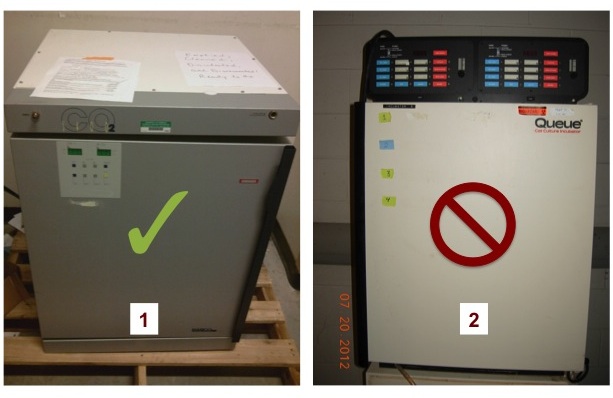To prevent the escape of biohazards into the environment, waste from biohazardous operations must be treated and/or disposed of in a special way. The following section reviews how to process and discard biohazardous waste appropriately, as well as other types of waste frequently generated in biomedical and animal laboratories.
Regulated Medical Waste, Biohazardous or Infectious Waste
The Department of Environmental Conservation (DEC) of the State of Vermont regulates the disposal of Solid Waste (SW). An important part of solid waste generated in the medical industry requires special handling and treatment prior to disposal in order to protect public health, safety, and the environment. This particular type of SW is known as Regulated Medical Waste (RMW), biohazardous waste, or infectious medical waste. RMW is heavily generated, not only by industries in the healthcare sector, but also by research institutions across the world.
Procedures addressing definitions, handling, and treatment of RMW (PDF) were published by Vermont's DEC.
The following types of solid waste, which you may encounter during your research or clinical work, fall under the category of Regulated Medical Waste:
- Pathological Waste: Human tissues, organs and body parts.
- Human blood, blood products, and other body fluids including:
- Liquid waste human blood, blood products and components
- Other potentially infectious liquid body fluids: amniotic, cerebrospinal, peritoneal, pleural, and synovial fluid
- Items saturated or dripping with blood or potentially infectious body fluids and those caked with dried blood or potentially infectious dried body fluids
- Cultures and stocks of infectious agents, including:
- Cultures and stocks of infectious agents from research, industrial and educational laboratories
- Discarded live and attenuated vaccines
- Culture dishes and devices used to transfer, inoculate and mix cultures
- Sharps - objects capable of cutting or penetrating the skin and inducing subdermal inoculation of an infectious agent, including:
- Needles
- Pasteur pipettes
- Scalpels and blades
- Discarded unused sharps
- Animal waste, including animal carcasses, body parts, bedding and other items from animals known or suspected by either the Department of Health or the Department of Agriculture of being contaminated with organisms that can produce disease in humans, and for which disposal by burial or other ordinarily acceptable means would not sufficiently reduce the risk of disease transmission to humans or other animals.
- Chemotherapy waste: Any material containing cytotoxic and/or antineoplastic agents during the preparation, handling or administration of the agent, including:
- PPE: masks, gloves, gowns...
- Empty IV tubing bags and vials
- Other contaminated materials
- Infectious isolation waste: biological waste and discarded materials contaminated with blood, body fluids, excretion, exudates or secretion from isolated humans with dangerous communicable diseases.
- Biotechnological by-product effluents: any discarded preparation made from genetically altered living organisms and their products.
Identify Biohazardous Waste Properly
All biohazardous waste containers must be labeled with a biohazard label (red or red/orange label with the universal biohazard symbol and the word BIOHAZARD underneath). Contact us at safety@uvm.edu if you need biohazard labels.
In addition, red or red/orange biohazard bags should be used for the disposal and/or autoclaving of biohazardous waste. Red biowaste bags are usually available in the HSRF supply cabinet, Terrill 109, and the biowaste room in the Colchester Research Facility.
Liquid Biohazardous Waste Management
Liquid biohazardous waste can be disposed of in different ways depending on the type of biological agent present, containing vessel, etc. The most frequently used method to discard liquid biohazardous waste is:
Chemical inactivation and pouring down the sink drain: Growth medium used in mammalian tissue culture, and bacteria or yeast culture, should be collected and inactivated for 20 minutes in a recipient containing a fresh bleach solution before being discarded down the drain. To collect such waste, aspirate it into a flask containing bleach
A - connected to a second overflow collection flask
B - also with bleach, and separated from the vacuum system
D - by an in-line filter
C - The final concentration of bleach in the flasks should be 10 to 20%, depending on the amount of organic load present. Bleach solutions maintain their activity for approximately one week, after which a new solution should be prepared. To ensure that all the biohazardous waste is neutralized before disposal, mix the contents of the flasks thoroughly with the bleach and allow a minimum contact time of 20 minutes.
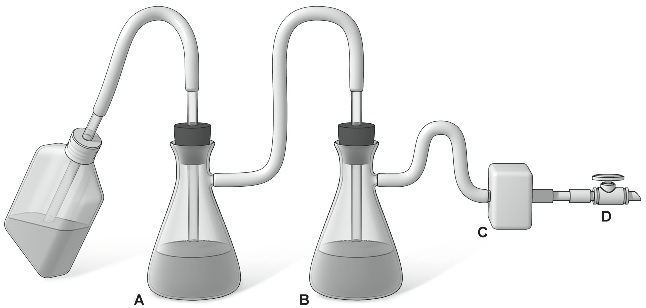
- If using a disinfectant other than bleach, please contact Environmental Health and Safety at: safety@uvm.edu to confirm whether the disinfectant can be safely and legally disposed of down the drain.
- If other hazardous chemicals are present in the biological waste, do not treat with bleach. Either label and tag the waste for pick up as hazardous waste or contact your lab safety coordinator for assistance.
If you need to dispose of frozen liquid samples, please refer to the Solid Biohazardous Waste Management section below.
Solid Biohazardous Waste Management
A large portion of the waste generated in microbiological and biomedical laboratories belongs to the category of Regulated Medical Waste and is treated as such. Before reaching its final destination, a cardboard biowaste box, the waste is discarded either in a properly labeled biohazard container lined with a red biohazard bag or a sharps container (or equivalent), as described below.
Collection in biowaste containers lined with red biohazard bags: Biologically contaminated solid waste should be deposited into biohazard containers (red biohazard bag in biohazard container). Some examples of biohazardous waste commonly found in the lab include: flasks, plates, and tubes used for cell culture; ELISA plates; bacterial plates; PCR, DNA, RNA, and protein-containing tubes and plates; flow cytometry tubes; parafin blocks with tissue; contaminated liners, paper tissue, and Kim wipes; blood and tissue samples... All biohazardous waste containers should be covered when not in use. Biowaste boxes should have a lid, and it is highly reccomended that they are kept off the floor, for example, by the use of a dolly. Biowaste box lids and dollies are available to order through UVM Chemsource.
Collection in sharps containers: Objects that can penetrate the skin such as scissors, scalpels, needles, razor blades, histology slides and coverslips, pasteur pipettes, serological pipettes, pipette tips and broken glass are considered sharps. Needles, razor blades, pasteur pipettes and broken glass contaminated with biological agents should only be collected in biohazard sharps containers. Similarly, all histology slides and coverslips used with biohazardous materials, whether fixed or not, should be discarded into a biohazard sharps container that will ultimately be deposited into a biowaste box. Biologically contaminated serological pipettes should be collected in a sharps container, or an equivalent receptacle (e.g., an empty serological pipette cardboard box with a biohazard sign), before being deposited into a biowaste box. When your sharps container is nearly full, seal the lid and place it in a biowaste box for disposal.
NOTE: Non-contaminated serological pipettes and pipette tips can be discarded in a broken glass box
Temporary collection in puncture-proof containers: Pipette tips can be collected in a puncture-proof container on the open bench and discarded into a biowaste box when full.
Autoclaving and collection in biowaste containers lined with biohazard bags: Based on a risk assessment of your work, you may need to autoclave the biowaste generated. For questions regarding whether you should autoclave your biowaste, please contact the Biosafety Officer at safety@uvm.edu.
Reminders
Minimize liquids in biowaste boxes - Biowaste boxes should be free of free liquids. If boxes are leaking, they will be left behind and you will be asked to repack them for the next pick-up. No chemicals should ever be packed in biowaste boxes.
Packing Frozen biohazardous material - Frozen carcasses, such as those from Animal Science labs or from UVM's Animal Care Facility, should be boxed up and brought to the Given loading dock early on Tuesday morning. This reduces damage to the box(es) caused by thawing of frozen material before the Tuesday morning biowaste vendor pick-up. During the summer months, frozen samples should be packed early on Tuesday morning before 8:00am. When packing frozen samples for disposal, seal them in 1-gallon zip-top bags before placing them into biowaste bags. If you are disposing of a large number of samples, you can also request a thick plastic liner for the box.
* If you are planning to dispose of frozen samples, please coordinate this with EH&S staff ahead of time by emailing safety@uvm.edu. *
Box Weight Limit - One individual biowaste box should never weigh more than 45 lbs. Less weight is better than more. If you think you are nearing the 45 lb limit, start a second biowaste box.
Double (Red) Bag - 2 red bags are required inside each biowaste box. Tie both bags before taping all sides of the carton with clear tape.
Animal Carcasses - Must be disposed through the Office of Animal Care Management (OACM). This type of waste is placed into sturdier biowaste boxes closed with a lid and labeled with Animal Care generator labels (instead of HSRF labels). Please direct your questions about animal disposal to the OACM at 802-656-1006.
Biowaste Box Disposal
Biowaste Box Labeling and Marking Procedure
Biowaste boxes, bags, and tape are available in Firestone 245D storage closet, CRF biowaste storage room, and Terrill 111.
All biowaste boxes originating from UVM labs should be labeled with the following:
- Lab Building and Room Number
- PI or Lab Group Name, and
- Contact Phone Number
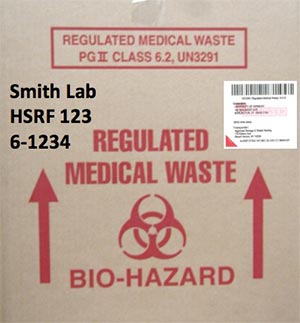
Please clearly write this information on the box with black marker.
Off-campus Biowaste Pickup
EHS Waste Technicians pick up biowaste boxes from off-campus locations and buildings that are far away from the biowaste shed early on Tuesday mornings. Labs located in the following buildings can call 802-656-5408 no later than Monday: BioResearch Area, Dewey, Hall, Perkins & Votey, Terrill, and Miller Research Farm. Please make sure biowaste boxes are packed and labeled and ready for pickup Tuesday morning.
Firestone/HSRF Biowaste Storage Area
Full biowaste boxes should be dropped off at the biowaste box storage room in Firestone/HSRF building 245C. This used to be the HSRF loading dock area. Biowaste supplies can be found in 245D.
Frozen animal carcasses or other frozen materials should ONLY be packed and brought to the biowaste storage room on Tuesday mornings, no later than 10:00 am.
Boxes moving through hallways must be sealed on all seams. Please transport boxes using a cart to avoid unnecessary breakage.
Please do not leave ANY biowaste boxes at the Given loading dock!
* Lab personnel will need CATcard access to Firestone/HSRF room 245C. To get access complete the Biowaste training and submit this: CATcard access form. *
Autoclaving Biohazardous Waste
ONLY BSL-3 lab are required to autoclave highly infectious materials and disposable labware that has been contaminated with it, prior to its disposal as Regulated Medical Waste. Autoclaving is used to achieve the sterilization or complete destruction of the microorganisms present in the autoclaved materials. For BSL-2 and BSL-1 labs, biowaste should NOT be autoclaved before placing in the biohazard waste box.
Both solid and liquid materials can be autoclaved using different programs. Special autoclave biohazard bags should be used for items that must be bagged before autoclaving, and a chemical indicator such as heat-sensitive tape (autoclaving tape) should be placed on every load. This tape changes color (from white to black) after being exposed to a specific temperature, verifying that the correct temperature was reached. However, the change in color does not confirm whether the appropriate contact time or sterilization was achieved.
VERIFY AND DOCUMENT AUTOCLAVE EFFECTIVENESS
If autoclaving biohazardous waste, autoclave effectiveness should be verified and documented, at least monthly, using a biological indicator. The spores of Geobacillus stearotermophilus are used as a biological indicator because they are among the most resistant living forms to steam autoclaving. To determine the effectiveness of the autoclaving process, the biological indicator must be placed in a typical test load (solid or liquid) and exposed to standard cycle conditions. Follow these procedures to use biological indicators:
- Read and follow the supplier's instructions.
- Place G. stearotheromophilus in the center of a representative test load.
- Process load in normal fashion.
- Extract and incubate the G.stearothermophilus sample as instructed by the manufacturer. Incubate another ampoule (from the same lot number) that has not been autoclaved (positive control).
- Check for color changes in the culture media at regular intervals during the incubation period (8, 12, 24, and 48 hours). If the media is yellow and turbid, the autoclave process has FAILED. Immediately re-run all samples with new biological indicators.
- If failure continues to be noted, either increase the exposure time or initiate repairs to the autoclave. Note: The autoclave cannot be used again until validation procedures indicate that the autoclave is properly sterilizing the contaminated materials.
- Record all results (positive and negative) in the autoclave notebook.
Biohazardous Waste Risk Minimization and Awareness
Improper handling of biohazardous waste can result in accidental exposure to infectious agents. Thus, all researchers who work with biohazardous agents are responsible for the proper treatment and disposal of biohazardous waste. They must keep in mind that other persons, such as custodians who clean the lab and the contractor who handles biowaste for its final transportation and disposal, are at increased risk for exposure.
The pictures below show some incorrect ways of disposing of biowaste in the lab and packaging it. Review what's wrong with each of them.
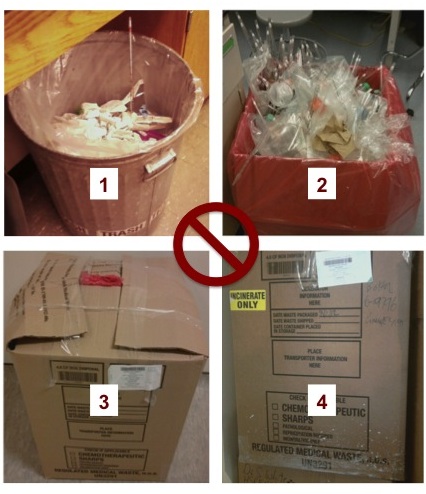
Picture 1: A serological pipette has been discarded in the regular trash. Even if the pipette was not contaminated with a biohazardous agent, it is considered a sharp because it can puncture the skin. Non-contaminated pipettes should only be discarded in the regular trash if properly packaged inside a puncture-resistant cardboard box.
Picture 2: Serological pipettes have carelessly been thrown into a biowaste box sticking out in different directions. Biologically contaminated pipettes should always be discarded in a sharps container or a puncture-resistant carboard box before being deposited into a biowaste box. Non-contaminated plastic sleeves that could go in the regular trash have also been discarded in the biowaste box. In addition, biowaste boxes and containers should be closed when not in use.
Picture 3: An overpacked box is bulging and exposing the inner biohazard lining bag. Biowaste boxes should be properly closed in a way that the inner contents are not exposed to the outside. In addition, they should not be overpacked and cannot exceed 55 lb. The biohazardous waste carrier may decline pick up of heavy and incorrectly packed boxes like this one, in which case the responsible researchers will be asked to open the box and repack the contents again into two different boxes.
Picture 4: The biowaste box is grossly contaminated near the bottom. Biowaste boxes should be free of exterior contamination. The biohazardous waste carrier may decline pick up of contaminated boxes like this one, in which case the responsible researchers will be asked to open the box and repack the contents again.
Unacceptable Disposal of Sharps and Other Items Contaminated with Blood
Sharps and other items contaminated with blood are not allowed in either broken glass boxes or uncontaminated lab waste and broken glass boxes. Such boxes are only allowed for the disposal of uncontaminated broken glass and uncontaminated lab waste (e.g., clean intact or broken glass bottles, flasks, Petri dishes, and beakers; serological pipettes used to dispense non-hazardous solutions - water, PBS, glucose solutions...- etc.). Needles and blades must always be discarded in sharps containers, whether they are contaminated or not.
The picture below shows a blood-stained broken glass box that was found in the HSRF biowaste shed full of items contaminated with blood, including used blood transfusion bags, blood collection tubes, needles, blades and slides. Such items must be collected in a sharps container and then deposited into a properly labeled biowaste box lined with two biowaste bags. Improper disposal of items, especially sharps, contaminated with blood pose an extreme risk to biowaste handlers. Since only biowaste boxes are approved for transportation, Risk Management & Safety personnel had to collapse the broken glass box and place it into a biowaste box.
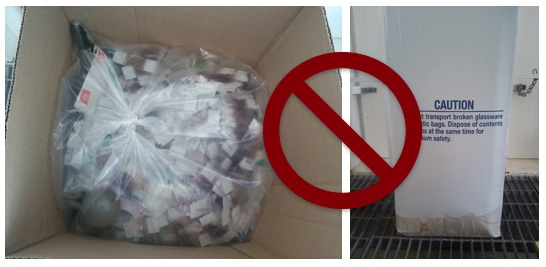
Freestanding sharps containers are not allowed for transportation. The picture below shows 4 freestanding sharps containers that were found in the HSRF biowaste shed full of items contaminated with blood, including used catheters with attached needles and contaminated paper/gauze. The front right container is not even properly closed. Sharps containers must be deposited into a properly labeled biowaste box lined with two biowaste bags before being placed on the loading dock or any biowaste storage room awaiting for transportation. Improper disposal of items, especially sharps, contaminated with blood pose an extreme risk to biowaste handlers.
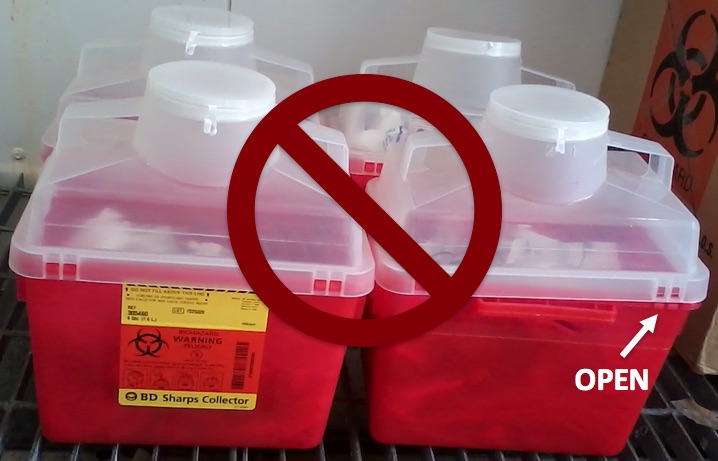
Decontamination and Disposal of Biohazardous Equipment
Laboratory equipment and appliances that have been used with biohazards should be thoroughly decontaminated, and have the biohazard labels removed, before being disposed of through the UVM Surplus Disposal Program.
- Instructions on how to get biologically contaminated equipment and appliances ready for disposal (PDF)
The picture below illustrates both the correct way of disposing of an incubator (Incubator 1: decontaminated, without biohazard labels and with Surplus Form attached) and the wrong way (Incubator 2: not decontaminated, with biohazard label and without Surplus Form).
